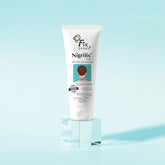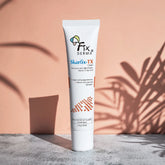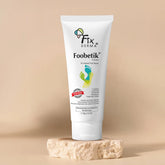Face Mapping and Acne: What Your Breakouts Are Telling You?
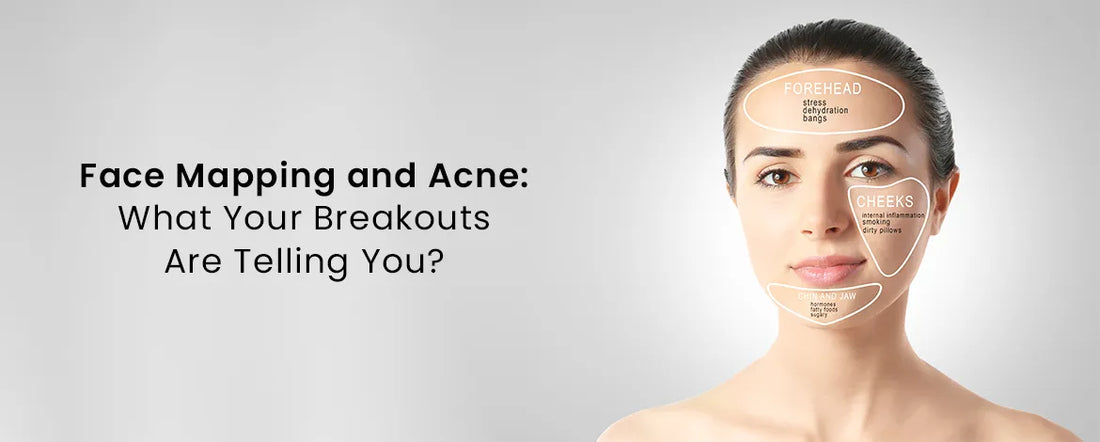
Tables of Content
- Are Your Breakouts Telling Something?
- What Is Face Mapping?
- Acne Location: What Your Acne Breakouts Mean?
- Causes of Acne Breakouts
- How To Identify Acne Locations In Face Mapping?
- How to Use Face Mapping for Acne Treatment?
- Face Mapping Tips for Clear Skin
- Face Mapping and Skin Health
- Achieving Clear & Radiant Skin With Face Mapping
- Frequently Asked Questions (FAQs)
Are Your Breakouts Telling Something?
Have you ever wondered why certain areas of your face seem to break out more than others? You’ve tried every cleanser, every serum, and yet, the breakouts persist. There’s more to acne than meets the eye, and this is where face mapping comes into play. Derived from ancient Chinese and Ayurvedic traditions, face mapping can offer insights into what your acne breakouts mean and help you get closer to achieving that clear, glowing complexion.
Let’s dive into the world of face mapping and breakouts to discover what your skin is trying to tell you. By understanding the breakout patterns on your face, you’ll be better equipped to address the root causes and not just treat the symptoms. Here's how face mapping for skin problems works and why it’s gaining popularity in the skincare world.
What Is Face Mapping?
Face mapping is an idea through which the face is divided into multiple zones to study and treat acne by addressing the underlying causes. Acne often indicates that internal organs or systems are not functioning properly. In this case, face mapping is a holistic approach toward the skin where we are encouraged to look beyond topical treatments but consider internal factors that might be influencing skin health.
In face mapping, the areas of the face are divided into zones where each zone is associated with an internal organ or system. This allows us to connect the external and internal factors to create a better picture and address the conditions well and completely. Let's take a closer look at the areas and systems associated with face mapping.
Acne Location: What Your Acne Breakouts Mean?
Each acne location provides a clue to understanding the underlying causes or systemic issues of the body. Acne, in most cases, is caused when the pores on the skin are clogged by excess sebum production, dirt, products, ingredients, etc. Acne vulgaris is an extreme condition where they even leave blemishes throughout the skin. This may also occur in the form of whiteheads, blackheads, cysts and bumps.
Causes of Acne Breakouts

Hormonal fluctuations, diet, genetics, underlying health conditions, hygiene practices, stress and even some medications can trigger acne. Let's read more about how each of these affects the skin, causing acne.
- Hormonal fluctuations: There are several reasons why hormonal changes can happen in the body including menstrual cycle, pregnancy, age, lifestyle, medicines, etc that may cause acne.
- Diet: Food containing high sugar levels, refined food, fast food etc can trigger acne by adding to excess sebum production.
- Genetics: Acne can also be passed on to an individual through genes. If any close family member has acne, your skin is more likely to have acne as well.
- Underlying Health Conditions: Acne can also occur as a result of an undiagnosed health issue. A common issue faced by females is Polycystic ovary syndrome, otherwise called PCOS.
- Hygiene Practices: Improper cleansing leads the dirt and products to clog the pores on the skin. Hence, daily cleansing is crucial.
- Stress: Stress results in hormonal fluctuations, imbalanced cortisol levels and steeped production of androgens that trigger acne. Without proper rest and sleep, stress also acts as a factor in slowing down the healing process in the body.
- Medications: Acne can occur as a side effect of steroids and medications like Halogens, Antiepileptics, Antidepressants, Corticosteroids, Lithium etc.
- Accumulation of Makeup & Products: Not all products available in the market are non-comedogenic. These products tend to clog the pores on the skin, causing acne breakouts to happen more often.
How To Identify Acne Locations In Face Mapping?

Understanding the *Acne Location and Causes* is the key to deciphering the message your skin is sending. Here’s a breakdown of common breakout zones and their potential causes:
Forehead:
Related to: Digestive System and Stress
Breakouts on the forehead are related to poor gut health or stress. Overconsumption of refined food and sugar can trigger acne in this area. Another common reason behind forehead acne is the transfer of oil and products from the head to the face.
Nose:
Related to: Oil Production and Hormonal Imbalance
The nose is a central part of the T zone area, which is oilier than the rest of the face. Breakouts here are often associated with excess sebum production, clogged pores, and hormonal fluctuations. The nose is also connected to the heart and blood pressure. Any issues related to the heart can lead to acne in the nose.
Chin and Jawline:
Related to: Hormones and Reproductive System
Excess androgens are the reason behind acne on the chin. These hormones stimulate the sebaceous glands to increase sebum production that clog the pores. Hormonal imbalances, especially those related to menstruation or polycystic ovary syndrome (PCOS), are common reasons for breakouts along the jawline and chin. Stress and poor diet can further aggravate the condition.
Cheeks:
Related to: Respiratory System
High sugar intake can cause acne on the cheeks. Breakouts on the cheeks are connected to respiratory issues. Pollution, smoking, and allergies are a few factors leading to acne breakouts in this area. Dirty pillowcases and bedsheets contribute to the condition as well.
How to Use Face Mapping for Acne Treatment?
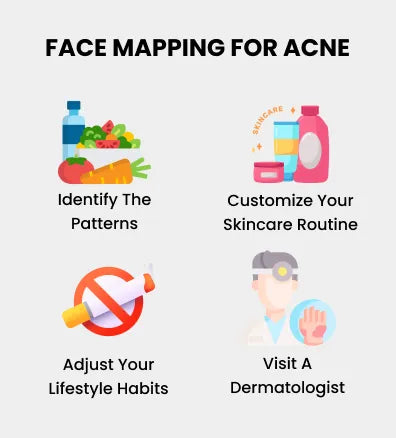
Using *Face Mapping for Acne* is not just about identifying the location of acne and its underlying causes but also understanding how to address it effectively. Here are some tips for you:
- Identify the patterns: Keep a check on the location and type of acne occurring in the area. Apart from that, know your lifestyle patterns such as diet, climatic conditions that affect your body, medication, etc.
- Customize your skincare routine: Check for ingredients and products that suit your skin type and address your skin conditions. For example, if you have breakouts on your forehead, consider adding a gentle exfoliant to your routine to improve cell turnover.
- Adjust your lifestyle habits: If acne is spotted on the cheek area often, consider switching to low-sugar or sugarless food habits. Quitting smoking, using clean pillowcases and proper cleansing of the face twice a day are other habits you can incorporate into your lifestyle.
- Visit a dermatologist: If you are unclear about what products to use or your skin type, get expert help. They will be able to take you through the concerns and create a skincare routine for you.
Face Mapping Tips for Clear Skin
Identify the concerned areas: Apply face mapping as a guide to determine the places where underlying issues are impacted and lead to the formation of acne.
Select the right products that address your skin concern: Each skin type needs unique products and treatments that address their skin concern effectively.
Zone specific approach: Spot treatments and dividing the face into zones are effective for all skin types. In particular, those with combination skin would find them beneficial.
Cleanse the face properly: You must use a gentle cleanser regardless of your skin type. If necessary, alter your skincare regimen. If done regularly, methods like double cleansing could do wonders for the skin.
Salyzap Daily Face Cleanser is a soap-free anti-acne face wash, designed to effectively combat acne while being gentle on the skin. It exfoliates the keratinized skin & removes excess sebum from the pores without stripping off the natural oils from the skin.
Use non-comedogenic moisturizers: Sometimes, each zone of the face might need a different type of hydration. Those with combination skin might be familiar with the process. Choose lightweight, non-comedogenic hydrating formulas for the best results.
Acne Control & Oil-Free Face Moisturizer is a nourishing and soothing moisturizer that is lightweight & non-greasy. This multitasking product tackles breakouts, controls oil production, and nourishes the skin – all in one!
Radiance & Oil-Free Face Moisturizer is a lightweight formula designed to deliver a radiant, matte complexion. The oil-free formula ensures that your skin stays hydrated without excess shine or oily feeling.
Do not skip SPF: Always and always apply a broad spectrum, sunscreen with an SPF of minimum 30 to protect your skin from UVA and UVB rays.
Fixderma Shadow SPF 50+ Gel is a gel-based sunscreen specially designed for sensitive, acne-prone skin. The lightweight and non-greasy formulation is packed with the most photostable sun-protecting agents, making it perfect for all-season sun protection.
Keep the progress in check: Once you start following a customized skincare routine, make sure to monitor all the changes. It’d be great if you could keep note or records s of the same.
Face Mapping and Skin Health
Understanding Acne with Face Mapping offers a holistic approach to skincare that considers internal as well as external factors. This targeted approach encourages you to go beyond usual, topical treatments while considering the overall health that affects your skin.
Face mapping helps you pinpoint the causes of acne in different areas of your face, making it easier to create a skincare routine that fits your skin’s unique needs. Simple changes, like eating better, managing stress, and balancing hormones, can tackle internal factors while using gentle, skin-friendly products that take care of external issues. This personalized approach helps you address acne more effectively. This approach doesn’t just offer a quick fix but also promotes long-lasting skin health by treating acne from the inside out. Ultimately, face mapping empowers you to achieve clearer, healthier skin by taking care of both your skincare and lifestyle.
Achieving Clear & Radiant Skin With Face Mapping
Face mapping is a technique that links skin issues to our internal health, thus helping to pinpoint what the problem is based on where it is located. Through the exploration of what triggers like diet, hormones, or cloggy skin affect your skin, you are more prone to make a custom skincare system that handles the internal and external factors. This way you will be able to cure acne and other problems through a diet that promotes absolutely clear skin without any complications, which greatly affects your general health as well. The tips will help you to progress along the way of having no more breakouts and being proud of healthy skin that doesn't need numerous procedures and medications.
Frequently Asked Questions (FAQs)
-
What is face mapping, and how does it promote clear skin?
Face mapping links areas of your face to specific internal health issues, helping identify the root cause of skin problems like acne. By addressing these internal factors, such as digestion, stress, or hormones, you can achieve clearer, healthier skin. -
How can face mapping help prevent breakouts?
Face mapping helps pinpoint the internal reasons behind breakouts in different facial zones. By treating these underlying causes—whether it’s poor diet, stress, or hormonal imbalance—you can prevent acne and maintain clearer skin. -
Which zones on the face are connected to specific health issues in face mapping?
In face mapping, the forehead is linked to digestion and stress, the nose to oil production and hormones, the cheeks to respiratory health, and the chin to hormones. Addressing these connections can help treat breakouts and promote clearer skin.
